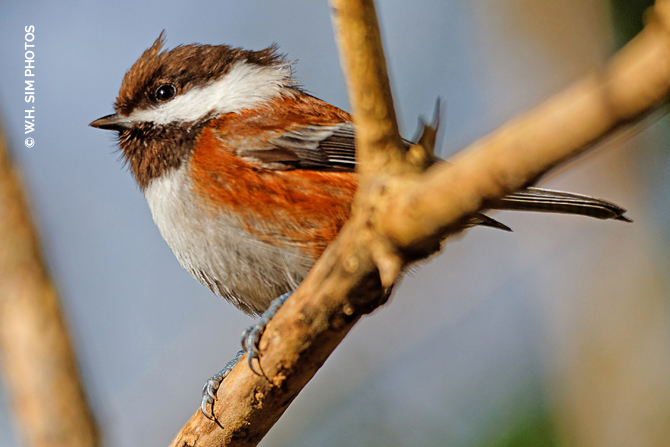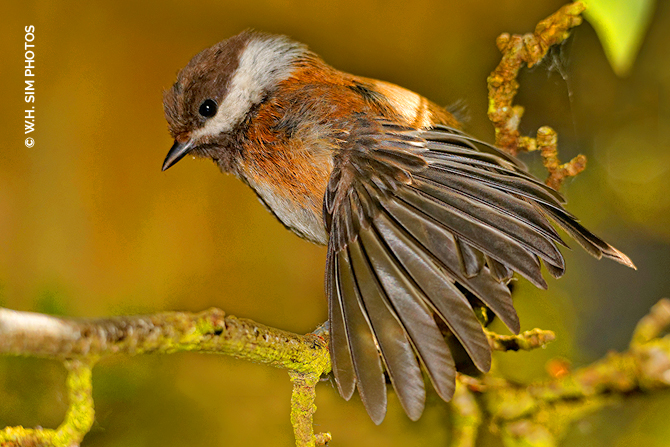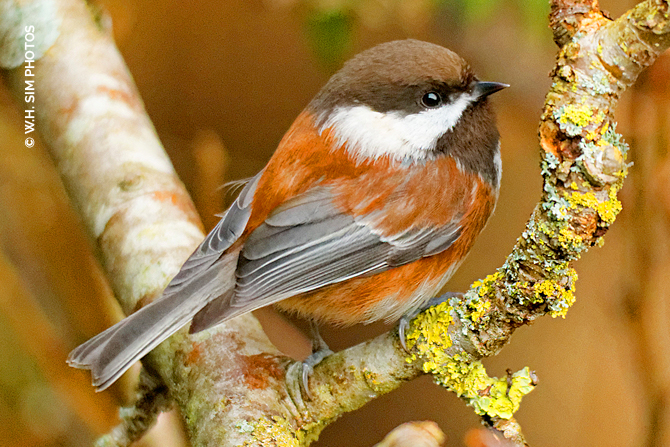This gallery contains 4 photos. Chestnut-Backed Chickadees are the smaller, less common cousins of the more ubiquitous Black-Capped Chickadees. We usually see one or two in the backyard, although during the past summer, a family of five (mom and dad with three successfully fledged juveniles) showed up regularly to raid the sunflower seed station. What CBCHs lack in numbers, though, they make up for with their boldness.

throwing me a backwards glance on the butterfly bush (taken on July 1, 2016)
f/10, 1/800, 500mm, ISO 500
The song of a CBCH is different from the BCCH, too … more liquid and melodious, and their alert call less “chiding.” You’ll also notice that CBCHs aren’t just chestnut on their backs; their flanks are a matching chestnut color, and even their crown and neck patches are dark brown. They are more likely to be much more comfortable with my lens than BCCHs. On more than a few occasions I have had the “privilege” of having a CBCH checking me out from just a few feet away. One of these hatch year juveniles also went so far as to perch on my long lens this summer (while I was using my camera — just like a Pine Siskin) for a few moments before realizing that it wasn’t a branch! I snapped the curious chap below at the Reifel Migratory Bird Sanctuary; while the Black-Capped Chickadees were depleting the small mound of sunflower seeds in my hand in less than 15 seconds, this little brown number was content to just sit on a nearby branch and catch some sun.

there was no wind to explain the “windswept hair” in this photo! (taken on Feb 2, 2016)
f/7.1, 1/800, 500mm, ISO 400
This smallest of short-tailed chickadees has a very narrow and restrictive range — they may be found almost exclusively on the Pacific coastline, from Alaska through to British Columbia down to California. Also, where the BCCHs (and Red-Breasted Nuthatches) exhibit rather frenetic “grab, dash, and dine” or “grab and cache” behaviours, the CBCHs are more inclined to sort through the sunflower seeds at a more leisurely pace before heading off to their favourite perch to enjoy or save for a rainy day–when they aren’t devouring insects, that is.

This nonchalant adult gave me a good look at its wing feathers (taken on June 16, 2015)
f/7.1, 1/800, 500mm, ISO 400, diffused flash
Sometimes, the juveniles will just sit at the feeding station and eat. Even the adults are less concerned about the humans who wander in their midst. Interestingly, our Chestnut-Backed Chickadees have never developed a fondness for hummingbird nectar (our Black-Capped Chickadees, on the other hand, have a sweet tooth that our Anna’s find highly annoying).

Classically posed on the denuded pear tree in the backyard last winter (taken on Dec 21, 2015)
f/6.3, 1/320, 500mm, ISO 4000
Although they are year round residents here, we most often see “our” CBCHs in the fall and winter. As spring rolls around, they (as most birds do) tend to do a disappearing act (in their case, into the mountains and higher elevation habitats) to court, mate, lay a clutch of eggs, and raise their offspring. Learn more about the Chestnut-Backed Chickadee by visiting its Cornell Lab of Ornithology allaboutbirds.org profile here.
MY ZAZZLE WEBSITE www.zazzle.com/walkswithnature
ON FACEBOOK www.facebook.com/whsimphotography
ON TWITTER www.twitter.com/whuisim
ON GOOGLE+ plus.google.com/u/0/+WHSIM

I love Chickadees- I have never seen one like this. They are such sweet and gentle creatures- I love their fearlessness when around people!
LikeLiked by 1 person
indeed! their antics add color and character to the backyard. 😀
LikeLike
Beautiful!!!
LikeLiked by 1 person
thank you, Debbie!
LikeLike
Excellent article and beautiful photographs!
LikeLiked by 1 person
thank you, Belinda!
LikeLiked by 1 person
Gorgeous shots! I love the one of the chickadee showing off his wing!
LikeLiked by 1 person
thanks, Alison! s/he was that comfortable with me. maybe even a little bored! 😀
LikeLike
Very beautiful !!! 🙂 🙂
LikeLiked by 1 person
grazie!! 🙂
LikeLiked by 1 person
🙂 🙂 🙂
LikeLike
Marvelous pictures of these pretty birds.
LikeLiked by 1 person
thank you, Lena!
LikeLiked by 1 person
These are wonderful! The colours are so rich.
LikeLiked by 1 person
thank you, Pete! the Chestnuts are one of my favorite tits … them and the bushtits. however, that may change if I ever met a Eurasian blue tit. 🙂
LikeLiked by 1 person
It’s cute that little Chestnut-backed Chickadee, beautiful photos.
I wish you a good day.
LikeLiked by 1 person
thank you, Hervé! have a great weekend.
LikeLiked by 1 person
Beautiful.
LikeLiked by 1 person
thank you, Gigi!
LikeLike
Pingback: Bird watercolor |